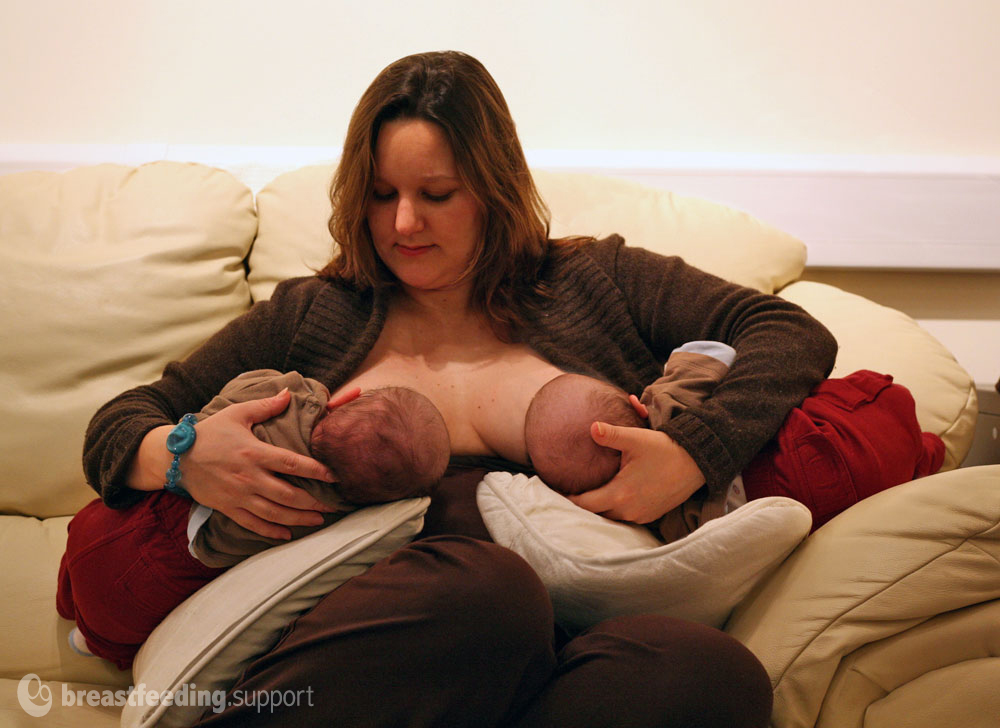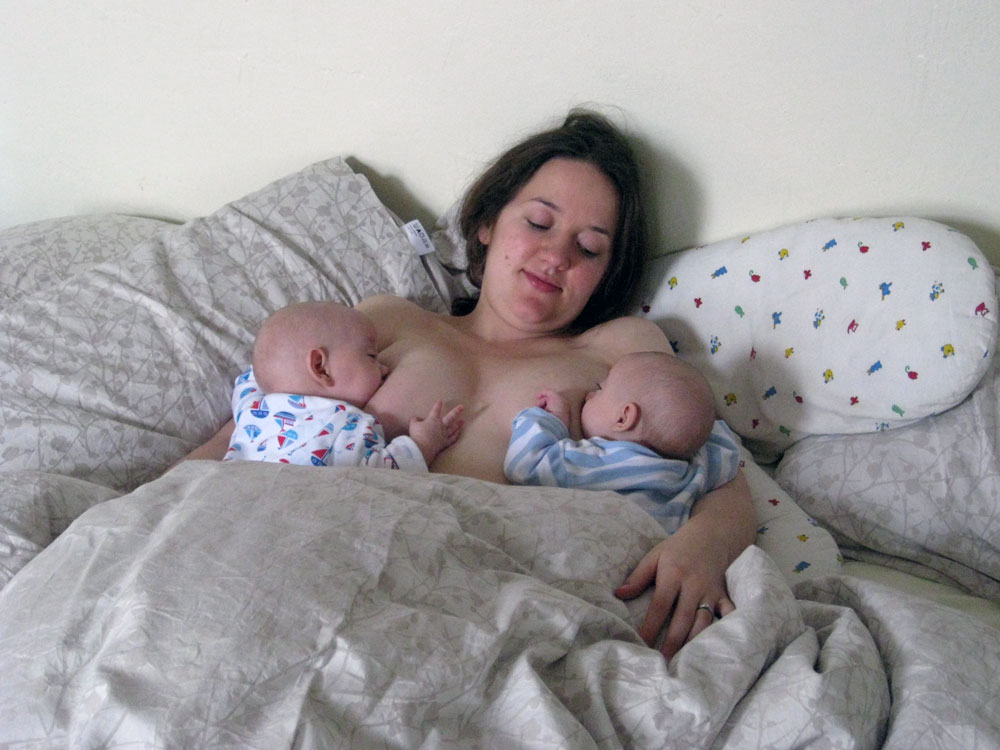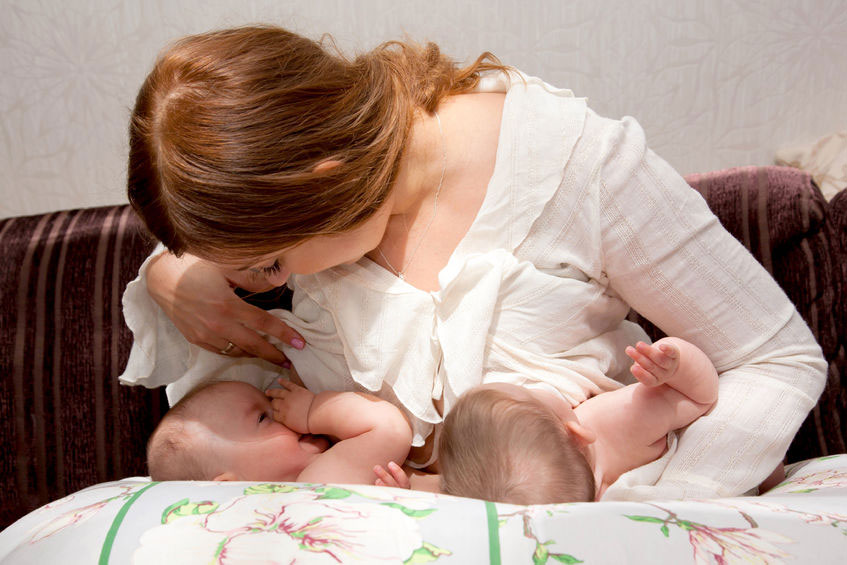Having more than one baby will inevitably bring more challenges to breastfeeding and mothering, but many mothers have successfully breastfed twins and triplets. This article answers ten frequently asked questions about breastfeeding twins (or more).
#1 Can a breastfeeding mother make enough milk for two babies?
Yes, a breastfeeding mother can make enough milk for two babies. Breastfeeding twins author Karen Kerkhoff Gromada explains that the more babies you have—feeding effectively—the more milk you will have because milk removal drives milk production.1 As long as your babies are emptying the breasts properly, and are able to feed as often as they like, in most cases mothers will make more than enough milk.23
What about more than two?
Flidel-Rimon et al look to history to explain that breastfeeding women have nourished many children, including children of different ages:
An historical answer may come from “wet nurses”, who could be viewed as having been the historical intermediate alternative between maternal breast milk and artificial formula. In foundling homes in France during the 17th century, each wet nurse fed three to six infants, who were often of different ages and with different daily requirements.
Older siblings
Some mothers may have an older sibling who still breastfeeds. Most mothers in this situation will make enough milk for the toddler and baby or babies. As the older child will also have access to solid food, but the baby will rely exclusively on breast milk, it is advisable to feed the younger babies first and be vigilant for signs your babies are getting plenty of milk.
Not enough milk?
Occasionally mothers of multiples may not seem to have enough milk, see #3 below.

#2 How will I know if each baby is getting enough milk?
Just as with having one baby at a time, there are several ways to check that your twins or triplets are getting enough milk such as:
- Keeping an eye on the number of dirty nappies
- Checking for effective, audible swallowing of milk
- Monitoring weight gain.
See Is My Baby Getting Enough Milk?, Breastfed Baby Poop and Understanding Your Baby’s Weight Chart for much more information. If you have any concerns about your baby’s milk intake, find a breastfeeding specialist as soon as possible to check breastfeeding is running smoothly.
#3 What if I don’t have enough milk for my twins?
Through the mechanics of “supply and demand” a mother will generally produce plenty of milk for twins or triplets or even an older sibling. However there can be situations where a mother may seem to have no breast milk after delivery, or other reasons for low milk supply. Mothers of twins or higher order multiples can have additional factors at play that may affect their milk supply including:
- Breast development of milk-making tissue may not be complete if babies are born early
- Feeding challenges associated with prematurity if babies are born early
- Hormonal issues that could affect milk production if there was a fertility issue with conceiving
- Not having good breastfeeding help from a specialist
- Increased incidence of pregnancy or birth complications such as pre-eclampsia or HELLP syndrome, gestational diabetes mellitus, anaemia, perinatal haemorrhage or surgical delivery.4
If either of your babies are not getting enough milk, you may need to supplement with donor breast milk or industrial formula while you work to increase your breast milk volume. Stay in close contact with your health professionals and consider contacting a breastfeeding expert to maximise your milk supply.
Making more milk for twins
Ways to make more milk when you are a mother of twins are the same as when breastfeeding a single baby. How your baby is latched (attached to the breast) and positioned, and how often you breastfeed your baby can all affect milk supply but these are not the only factors to consider. See How to Make More Breast Milk, Hand Expressing, and How to Increase Milk Supply by Pumping and contact an IBCLC lactation consultant for a tailored care plan for you and your babies.
#4 Is breastfeeding twins difficult?
With breastfeeding there is no formula to prepare, no bottles and teats to sterilise, milk is always instantly available at the right temperature and, once you get the hang of it, you can feed two babies at once and save time. However, there may be some breastfeeding challenges to overcome initially, particularly if your babies are premature.
#5 When can I breastfeed if my babies are premature?
Many twins or multiples arrive early and prematurity can bring more challenges, however breast milk is vital for these tiny babies and they can begin to breastfeed from 28 weeks gestation. See our related articles: Breastfeeding a Premature Baby, Kangaroo Care for your Premature Baby and Human Milk Fortifiers for further information.
If your babies are not latching yet
- If your babies are too small to latch and breastfeed, start hand expressing your milk straight away, within an hour of the birth is ideal. Later when your milk has come in you can use a hospital grade pump (generally the better the pump, the more milk you will get). Every precious drop of colostrum will be very valuable to your babies.
- Until your babies can breastfeed, hand express and/or pump as often as your babies would be breastfeeding if they could. A good guide will be at least every two hours during the day and every four hours at night. See Exclusively Pumping Breast Milk, and How to Increase Milk Supply When Pumping for lots of techniques to maximise your milk supply.
- Holding your babies skin-to-skin can help both your milk supply and help breastfeeding get started sooner, and see Kangaroo Care for your Premature Baby.

#6 Is it better to switch breasts or keep each baby to one breast?
There are several options for breastfeeding your twins and no right or wrong as long as each baby is getting enough milk and growing well. Options include:
- Offer each baby one or both breasts at each feed.
- Keep each baby on the same breast for 24 hrs then switch them to the opposite breast for the next 24 hours and repeat.
- Keep each baby on one breast for all feeds.
Switching breasts
Karen Kerkhoff Gromada author of Mothering Multiples: Breastfeeding and Caring for Twins or More says most mothers switch breasts either every feed or every other day:
most mothers switch babies and breasts, because breasts are less likely to look or feel lopsided. Switching may also provide babies with optimal eye stimulation. And, if one baby ever can’t or won’t breastfeed for a few days for some reason, switching ensures that the second multiple breastfeeds (and removes milk) from both breasts until the other baby is back to breast.
Breastfeeding is said to optimise a baby’s hand-to-eye coordination. Switching breasts or using positions that allow both eyes and hands to be stimulated is likely to be helpful to balanced development.
Assigning one breast per baby
Some mothers may prefer to keep a baby permanently assigned to one breast. This could allow the breasts to individually balance supply and demand for each baby. However, not all breasts work the same or have the same storage capacity or flow rate of milk, even within the same mother. Mothers may need to be aware not to match a baby who doesn’t feed effectively with a breast that has a slow flow or small storage capacity. In all cases, watch out for a baby who is not gaining weight well. Karen Kerkhoff Gromada suggests assigning one breast per baby might be reserved for situations where babies seem to have a preference for a particular breast:
Sometimes one multiple seems to “prefer,” or feeds much better on, a particular breast. Occasionally, switching breasts seems to contribute to digestive upset for one/more multiple, and “assigning” each a particular breast for all feedings alleviates the symptoms of discomfort.
Triplets
When breastfeeding triplets, two babies can be fed together, and then the third baby can feed from both breasts with all babies being rotated at the next feed. For more reading see Breastfeeding Triplets by lactation consultant Kathryn Stagg.

#7 Is it better to breastfeed twins at the same time or separately?
Whether to feed twins separately on demand, or at the same time, is personal choice. Feeding one baby at a time might be easier at first while mother and babies are learning how to breastfeed. If a mother experiences sore nipples at any stage—one or both babies’ latch may need improving and the mother will need to pay careful attention to each baby’s positioning.
Advantages of simultaneous feeding
- Saves time
- A stronger baby can initiate a let down for a weaker baby
- Feeding both babies at the same time may help stimulate your milk supply however Kerkhoff Gromada writes that this theory is not proven and seems based only on the knowledge that pumping both breasts at the same time can help your milk production. She notes that most mothers of twins produce plenty of milk irrespective of whether they feed simultaneously—as long as they respond to babies feeding cues.5
Disadvantages of simultaneous feeding
- Feeding babies simultaneously can be tricky if babies need help latching, however laid back positions where your body supports the weight of your babies, or careful use of firm V-shaped or special twin pillows combined with rugby/clutch hold positions can free your hands to help position your babies
- Babies can distract each other when older, or even refuse to feed unless their twin also feeds at the same time.6

#8 What are the best breastfeeding positions for feeding twins at the same time?
One position is not necessarily better than another. Different positions may suit different mothers and babies according to their individual anatomy. The principles of positioning two babies are the same as for one baby, see Breastfeeding Positions for Newborns. Common breastfeeding positions for twins include:
- Double rugby (double football, or double clutch hold)—a baby is held under each arm at breast height with their feet pointing behind their mother.
- Laid back (double prone or upright latch)—babies feed on their tummies (prone) with mother leaning back slightly so that her body is taking her babies’ weight. Another version of this is the front double straddle hold where each baby sits astride one of his mother’s legs and feeds on his tummy facing the breast.
- Cradle and rugby hold together—one baby feeds in a cradle hold in the crook of his mother’s arm, with the other baby in a rugby hold.
- Lying down—another version of laid back or prone feeding; babies feeding on their tummies.
- Double cradle (front cross or crisscross hold)—This position can be difficult if babies need help latching, as there are no hands free. The mother in the photo below uses a pillow to support an older baby in cradle hold.
Breastfeeding pillows
For more information about the types of commercial pillow available for simultaneously breastfeeding twins see Kathryn Stagg’s Specialist Twin Breastfeeding Pillows. Are they necessary and which one do I buy?


#9 What if one baby is better at feeding than the other?
It is common for one baby to be better at feeding than the other or for one to be sleepier and to need reminding to breastfeed. It may be helpful to feed twins separately until both babies are confident feeders. If feeding at the same time, positioning and attaching the baby who needs more help first, and then supporting him with one hand, before helping the more competent baby to latch with the other can be useful. If one baby has a weaker suck, simultaneous feeding will allow the let-down to be stimulated by the stronger baby. See our Breastfeeding Tips for Newborns and Latching Tips and seek help if needed.
#10 Do I need a special diet for breastfeeding twins or more?
A nursing mother of twins can eat and drink pretty much whatever she likes, just as a mother of a single baby can. See Best Breastfeeding Diet and Foods to Avoid. She will need to drink to thirst and will need an extra 500 calories per day per extra baby:
Eating a nutritious diet, nursing frequently, and choosing a night‐time sleeping arrangement that allows the best sleep for all involved are important issues that are often overlooked.
Current recommendations for energy supplementation during breast feeding are 2100–2500 kJ (500–600 kcal) per baby per day
Summary
Some of the challenges of breastfeeding a baby and breastfeeding a premature baby can be magnified when having twins or triplets. It is important that a mother of multiples gets as much help and support as possible so she can concentrate on feeding her babies. With the right help it is quite possible to make plenty of breast milk for two or more babies. There is no right or wrong way to go about sharing breasts when breastfeeding twins.